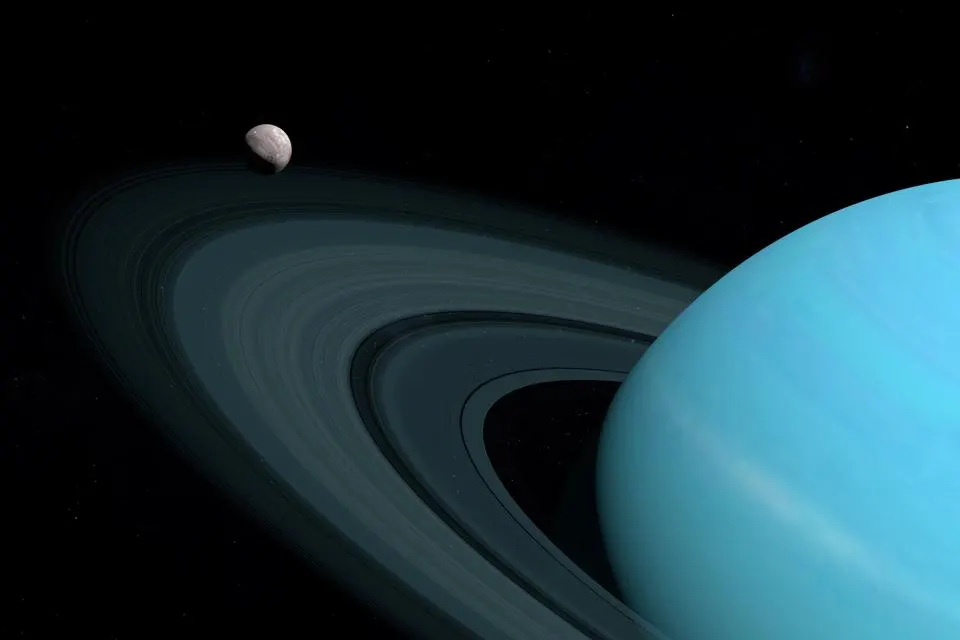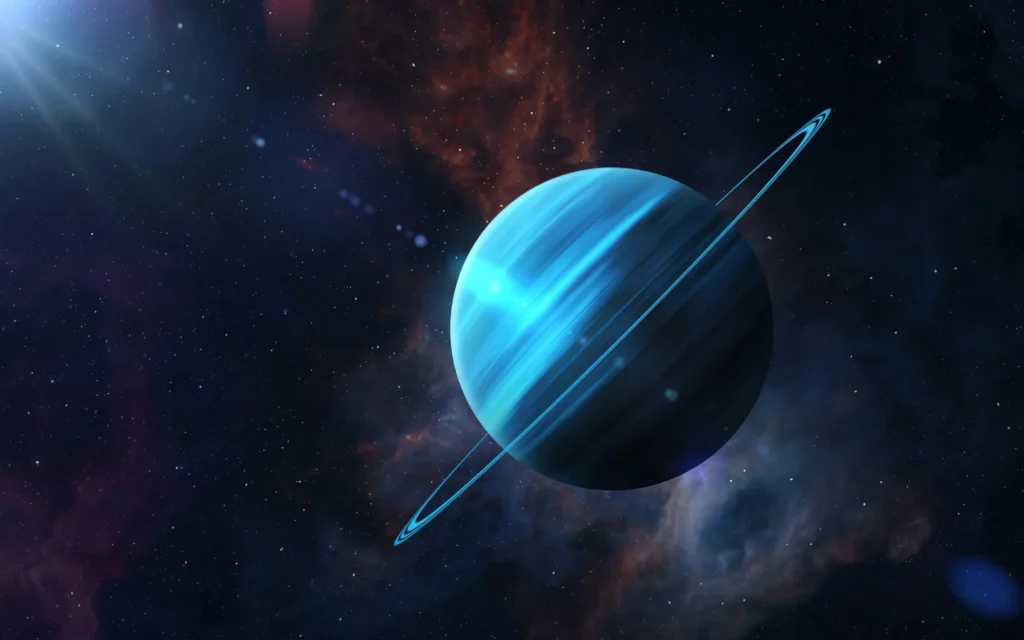When you hear about Uranus, maybe you wonder, why is it tilted? This big, blue-green planet has some mysteries. Unlike other planets, Uranus spins sideways. It has weird weather, cold temperatures, and even some rings that are not like Saturn’s. You might be curious why this is so and what makes Uranus different.
Uranus, often called the “sideways planet” because of its unusual tilt, remains one of the most fascinating celestial bodies in our solar system. Its striking blue-green hue, icy atmosphere, and unique characteristics set it apart from other planets. Today, we’ll delve into why Uranus is tilted, what it’s made of, and much more, to help you understand this distant world better.
This article will help you understand why Uranus is unique, focusing on its tilt, what it’s made of, its moons, and its rings. You’ll see all this and more in this article.

Why Is Uranus Tilted on Its Side?
The tilt of Uranus is one of the most intriguing aspects of this planet. Unlike Earth and most other planets, Uranus spins almost sideways on its axis. This extreme tilt, nearly 98 degrees, causes it to have unusual seasons, with each pole experiencing 42 years of sunlight followed by 42 years of darkness.
Scientists believe that this tilt may have been caused by a massive collision with an Earth-sized object early in the planet’s history. This impact likely knocked Uranus onto its side, forever changing the way it interacts with the sun.
Composition of Uranus: What Is Uranus Made Of?
Uranus is classified as an “ice giant,” a term that refers to its composition rather than its temperature. The planet’s atmosphere is primarily composed of hydrogen and helium, similar to Jupiter and Saturn. However, what sets Uranus apart is its higher concentration of “ices,” such as water, ammonia, and methane.

Methane plays a crucial role in Uranus’s distinct blue-green color, as it absorbs red light and reflects blue. Beneath the atmosphere lies a mantle of water, ammonia, and methane ices, followed by a rocky core.
Moons of Uranus: What Are the Most Important Moons?
Uranus has 27 known moons, with the largest and most significant being Titania, Oberon, Miranda, Ariel, and Umbriel. Each of these moons has unique features:
- Titania: The largest moon, known for its large canyons and valleys.
- Oberon: Features numerous impact craters and ancient surface.
- Miranda: Perhaps the most interesting, with its varied terrain and large cliff, Verona Rupes, the tallest known cliff in the solar system.
- Ariel and Umbriel: Both are characterized by heavily cratered surfaces, with Ariel showing signs of past geological activity.
Uranus’s Rings: What Makes Them Unique?
Uranus is encircled by a faint system of rings, much darker and narrower compared to the bright, wide rings of Saturn. Discovered in 1977, these rings are composed mainly of small, dark particles. They are believed to be relatively young and possibly formed from the remnants of moons shattered by impacts or tidal forces.
The rings are primarily made up of water ice, mixed with some dark organic material. Their dark color may result from radiation exposure, altering the chemical composition of the materials within the rings.

Temperature and Weather on Uranus
Uranus holds the record for being the coldest planet in our solar system, with temperatures plunging as low as -224 degrees Celsius (-371 degrees Fahrenheit). This extreme cold is due to the planet’s lack of internal heat, unlike other gas giants that radiate more energy than they receive from the Sun.
Despite these frigid conditions, Uranus experiences some intense weather, including powerful winds that can reach speeds of up to 900 km/h (560 mph). These winds, combined with the planet’s tilt, lead to unique and extreme seasonal changes.
Exploration of Uranus: What Have We Learned?
Our most significant insights into Uranus come from the Voyager 2 spacecraft, which flew by the planet in 1986. Voyager 2 provided the first close-up images of Uranus, its rings, and its moons, revealing many of the features we know today.
Currently, there are no active missions to Uranus, but there is growing interest in returning to this distant world. Future missions could provide more detailed information about its atmosphere, rings, and moons, further unraveling the mysteries of this ice giant.

Conclusion
Uranus is a world of extremes, from its unique tilt and frigid temperatures to its faint rings and mysterious moons. As we continue to explore the outer reaches of our solar system, Uranus remains a key destination for future missions, holding many secrets yet to be uncovered. If you’re intrigued by what we’ve discussed, be sure to check out more articles on galaxysecrets.com and share your thoughts or questions with us!
FAQs about Uranus
How did Uranus get its tilt?
Scientists believe that Uranus’s extreme tilt was caused by a massive collision with a celestial object, possibly an Earth-sized protoplanet, early in its history. This impact likely knocked the planet onto its side.
Why is Uranus colder than Neptune?
Despite being farther from the Sun, Uranus is colder than Neptune because it radiates very little internal heat. This lack of internal warmth, combined with its distance from the Sun, makes it the coldest planet in our solar system.
What is the composition of Uranus’s atmosphere?
Uranus’s atmosphere is composed mainly of hydrogen and helium, with a significant amount of methane. The methane is responsible for the planet’s blue-green color.
How many moons does Uranus have?
Uranus has 27 known moons, with the largest being Titania, Oberon, Miranda, Ariel, and Umbriel. These moons vary in size and surface characteristics, with some showing signs of geological activity.
What did Voyager 2 discover about Uranus?
Voyager 2’s flyby of Uranus in 1986 provided the first detailed images of the planet, its rings, and its moons. The mission revealed the complex structure of Uranus’s rings, discovered 10 new moons, and provided data on the planet’s atmosphere and magnetic field.








